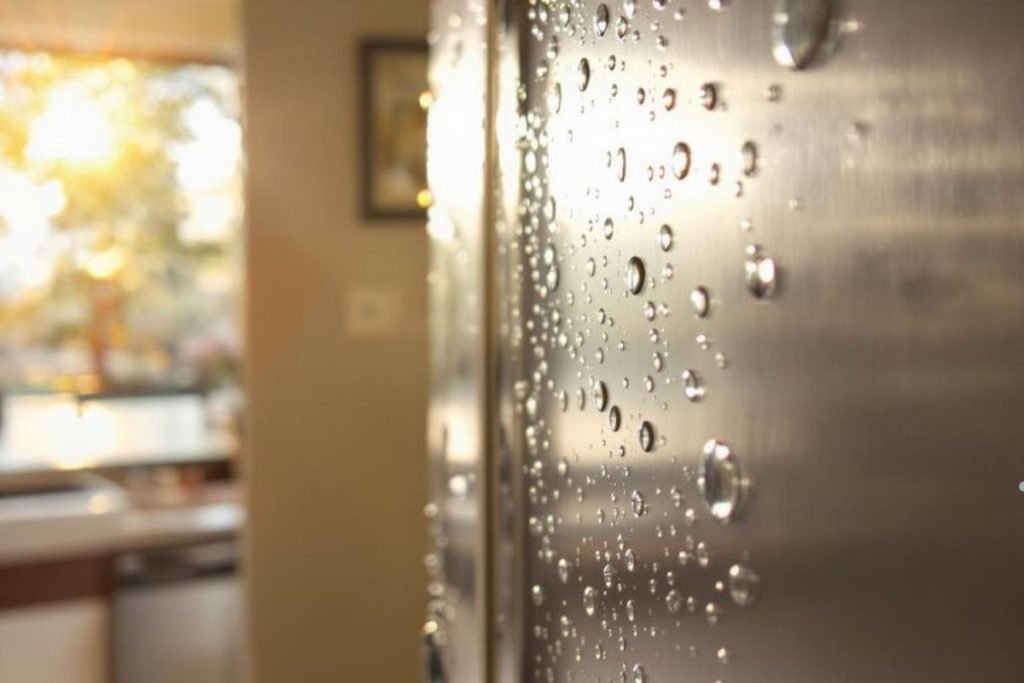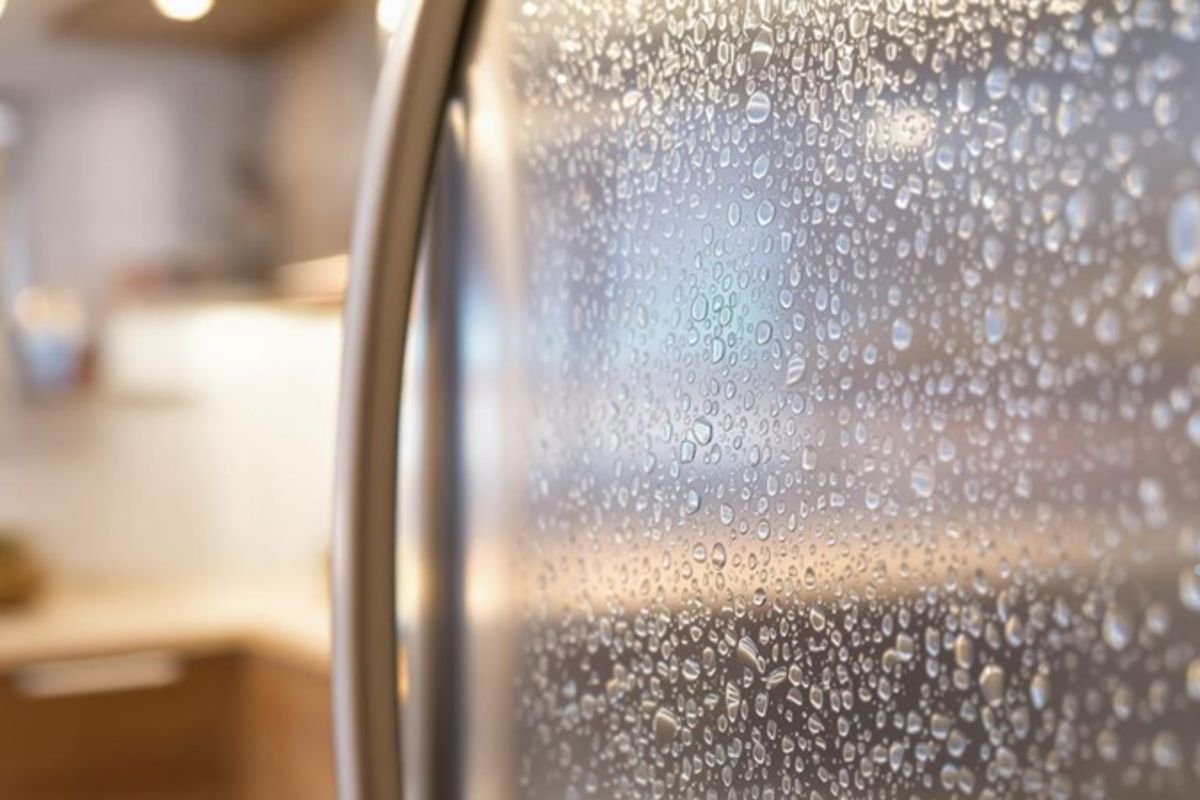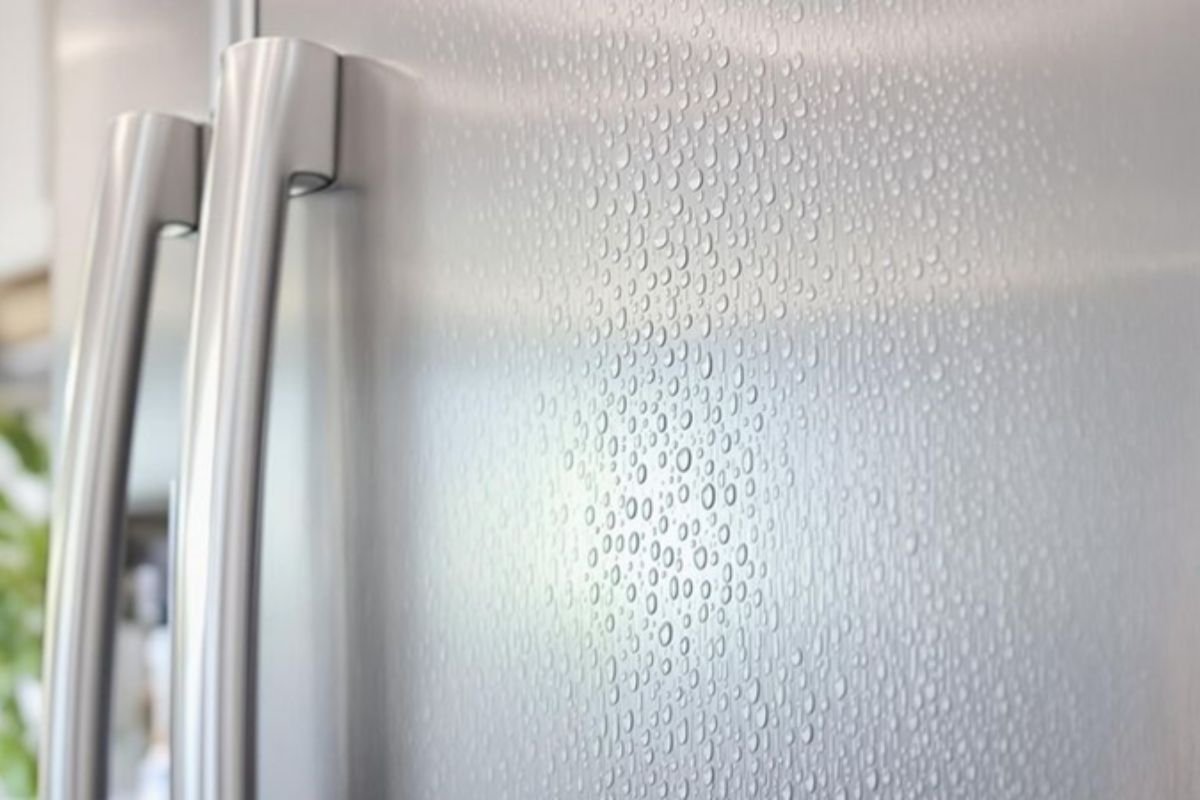
Ever notice water droplets inside your fridge or even puddles on the shelves? It’s not just annoying—it could mean there’s a bigger issue. In Los Angeles, with its mix of coastal humidity and warm weather, refrigerator condensation can be a common problem. But don’t worry, there are ways to tackle this. Let’s break down what causes it and how you can prevent it.
Key Takeaways
- Humidity in Los Angeles can make refrigerator condensation worse.
- Temperature differences inside and outside your fridge lead to moisture.
- Opening the fridge door too often can cause water droplets to form.
- Worn-out door seals are a major cause of condensation issues.
- Regular maintenance and managing indoor humidity can help prevent problems.
The Science Behind Refrigerator Condensation

How Humidity Levels in Los Angeles Contribute to Condensation
Los Angeles is known for its coastal climate, which means higher humidity levels in certain areas. When the moist air from outside interacts with the cold surfaces of your refrigerator, condensation forms. This happens because warm air holds more moisture, and when it cools down, it releases that moisture as water droplets. In places like LA, where the air can shift between dry and humid depending on the time of year, this process can be more noticeable.
The Role of Temperature Differences Inside and Outside the Fridge
Refrigerators work by keeping the inside cold while the outside air is usually warmer. This temperature contrast is what makes them effective at preserving food, but it’s also what leads to condensation. When warm, humid air sneaks into the fridge—say, when you open the door—it cools rapidly. This cooling causes water vapor in the air to turn into liquid, sticking to the fridge walls, shelves, or even your food packaging.
Understanding the Impact of Door Openings on Moisture Build-Up
Every time you open your fridge door, you’re letting in warm air from your kitchen. If you do this frequently or leave the door open for too long, you’re inviting excess moisture inside. Over time, this can lead to visible water droplets, a slippery mess on shelves, or even mold growth. To minimize this, try to plan what you need before opening the fridge and close the door quickly.
A little mindfulness about how often and how long you open your refrigerator can go a long way in reducing condensation issues.
At LA Appliance Innovators, our services include expert kitchen appliance repair, laundry machine repair, and HVAC system maintenance, catering to the needs of both homeowners and businesses. We are committed to delivering reliable and efficient appliance repair solutions, ensuring your essential devices function smoothly and effectively.
Common Causes of Refrigerator Condensation in Los Angeles Homes
The Effect of Coastal Climate on Refrigerators
Living near the coast in Los Angeles means dealing with naturally high humidity levels. This excess moisture in the air can easily find its way into your fridge, especially if the door is opened frequently. The salty air can also speed up wear and tear on seals, making it easier for warm, moist air to sneak in. Over time, this can lead to noticeable condensation inside your refrigerator.
How Poor Ventilation Can Lead to Excess Moisture
A refrigerator needs proper airflow around it to function well. If it’s crammed into a tight space or surrounded by clutter, the heat it generates can’t escape. This creates a pocket of warm, humid air around the appliance, which can seep inside and cause condensation. Make sure there’s at least a few inches of space on all sides of your fridge to allow for good ventilation.
The Role of Worn-Out Door Seals in Condensation Issues
Door seals, or gaskets, are the unsung heroes of your fridge. They keep cold air in and warm air out. But when these seals get old, cracked, or dirty, they stop doing their job. Even a small gap can let in enough warm air to cause moisture to build up inside. Regularly check the seals for damage, and clean them to ensure they’re making a tight seal. If they’re beyond repair, replacing them is a simple fix that can save you a lot of trouble.
Experiencing refrigerator condensation in your Los Angeles home? Don’t let moisture issues affect your appliance’s performance! Call us for expert diagnosis and repair. Our technicians are ready to help—schedule your service now!
How to Prevent Refrigerator Condensation in Humid Climates
Tips for Managing Indoor Humidity Levels
Managing humidity indoors can make a big difference in keeping your fridge free of condensation. Start by using exhaust fans in areas like the kitchen and bathroom, especially when cooking or showering. Keeping windows open during cooler, less humid times of the day can also help improve airflow and reduce moisture. Additionally, investing in a whole-house dehumidifier can prevent excessive dampness from entering your refrigerator, helping to maintain optimal humidity levels and avoid alterations in food quality.
The Importance of Regular Refrigerator Maintenance
A little upkeep goes a long way. Clean the coils at least twice a year to ensure your fridge runs efficiently. Check the door seals regularly—if they feel loose or cracked, they might be letting in warm, moist air. Don’t forget to defrost your freezer occasionally too, as ice build-up can contribute to moisture problems. Keeping your fridge at the right temperature (usually between 37°F and 40°F) is another easy way to avoid condensation.
Using Dehumidifiers to Reduce Moisture Around Appliances
Sometimes, the air around your fridge is just too humid, especially in sticky climates. Placing a small portable dehumidifier near the appliance can help keep the surrounding air dry. This is especially useful for homes in coastal areas or during the rainy season. For a more comprehensive solution, consider investing in a whole-house dehumidifier to tackle the issue at its source. It’s a practical way to protect not just your fridge, but your entire home from excess moisture.
Signs Your Refrigerator May Have a Condensation Problem

Visible Water Droplets on Shelves and Walls
If you notice water droplets forming on the inside walls or shelves of your fridge, it’s a clear sign something’s off. These droplets can come from trapped moisture that’s not being properly managed. This excess moisture can lead to more serious problems like mold or food spoilage. Keep an eye out for small puddles or dripping water that seem to reappear even after cleaning.
Unusual Odors Caused by Excess Moisture
Excess moisture inside your refrigerator can create a damp environment that’s perfect for bacteria and mold to thrive. This often leads to strange, unpleasant smells. If your fridge has an odd odor despite being regularly cleaned, it might be due to hidden moisture collecting in hard-to-reach areas. Take a moment to sniff around and see if the smell is stronger near certain spots.
Increased Energy Bills Due to Overworking Appliances
A fridge dealing with condensation problems often has to work harder to maintain its temperature. This means it’s using more electricity, which can show up as a noticeable spike in your energy bill. If your utility costs are climbing and you can’t pinpoint why, your refrigerator might be the culprit. Compare your current bill to past months to spot any unusual jumps.
Don’t ignore these signs—small issues can snowball into bigger, more expensive problems over time. Regularly checking your fridge for condensation clues can save you money and hassle in the long run.
Choosing the Right Refrigerator for Los Angeles Weather
Features to Look for in a Condensation-Resistant Fridge
When shopping for a refrigerator in Los Angeles, you’ll want to focus on features that help combat condensation. A reliable moisture control system is a must, especially in areas with fluctuating humidity. Look for models with built-in humidity controls or dual evaporators. These features help keep the fridge’s interior at a consistent temperature and moisture level, reducing the chance of water droplets forming.
Additionally, consider refrigerators with anti-condensation coatings on their doors and walls. These coatings prevent moisture from building up, even in humid environments. Adjustable shelves and compartments that seal tightly can also help manage moisture by keeping airflow steady inside the fridge.
Energy-Efficient Models for Humid Environments
Energy efficiency is another key factor. Los Angeles summers can get hot, and refrigerators tend to work harder in warm weather. Models with Energy Star certification are designed to use less electricity, saving you money in the long run. They also tend to have better insulation, which keeps the interior temperature stable even when the kitchen gets warm.
Need help finding the right refrigerator for Los Angeles weather? Call us today for expert advice and top recommendations!
Here’s a quick comparison of energy-efficient features to look for:
| Feature | Benefit |
| Inverter Compressor | Uses energy more efficiently |
| LED Lighting | Consumes less power than traditional bulbs |
| Smart Cooling Technology | Maintains consistent temperatures |
The Benefits of Smart Refrigerators with Climate Control
Smart refrigerators are more than just a tech trend—they’re practical for managing condensation. Many models now come with climate control features that automatically adjust humidity and temperature based on the environment. This is especially useful in cities like Los Angeles, where the weather can change quickly.
Some smart fridges even send alerts to your phone if the door is left open or if the internal temperature rises unexpectedly. This can prevent excess moisture from forming and keep your food fresh longer. Plus, with apps and touchscreens, you can monitor energy usage and make adjustments to save on electricity.
Investing in a fridge with the right features can make a huge difference in managing condensation and keeping your energy bills under control. Think of it as a long-term solution for a common household issue.
For an affordable and versatile option, consider the Euhomy beverage cooler. It’s a great choice for those seeking a reliable cooling solution without overspending.
DIY Solutions for Tackling Refrigerator Condensation
How to Replace Faulty Door Seals at Home
A worn-out door seal can be a major culprit behind refrigerator condensation. To fix this, start by inspecting the gasket for any cracks or tears. If it’s damaged, replacing it is straightforward. Here’s how:
- Purchase the correct gasket for your fridge model. Double-check the size and compatibility.
- Remove the old gasket by pulling it off gently. You might need a screwdriver to loosen any screws holding it in place.
- Clean the groove where the gasket sits with warm, soapy water. Let it dry completely.
- Align the new gasket and press it firmly into the groove. Tighten any screws if necessary.
- Test the seal by closing the fridge door with a piece of paper in between. If the paper doesn’t slide out easily, the seal is good.
Replacing a gasket might seem intimidating, but it’s a simple task that can save you from bigger issues later.
Steps to Improve Air Circulation Around Your Fridge
Poor air circulation can trap moisture, leading to condensation. Here’s how to ensure your fridge has the ventilation it needs:
- Move the fridge away from walls. Leave at least 2-3 inches of space behind and on the sides.
- Regularly clean the coils at the back or bottom of the fridge. Dust buildup can affect airflow.
- Avoid overloading your fridge with groceries, as this blocks internal air circulation.
Improving airflow not only reduces condensation but also helps your fridge run more efficiently.
Simple Cleaning Hacks to Prevent Moisture Build-Up
Keeping your fridge clean can go a long way in managing condensation. Follow these easy cleaning tips:
- Wipe down shelves and walls with a mixture of vinegar and water to remove any moisture.
- Clear out the drain pan at the bottom of the fridge. If it’s clogged, flush it with warm water using a turkey baster and remove debris with a pipe cleaner.
- Dry all surfaces thoroughly after cleaning to prevent water from pooling.
A little regular maintenance can save you from much bigger headaches down the line. Take 15 minutes every couple of weeks to clean and inspect your fridge—it’s worth it!
When to Call a Professional for Refrigerator Condensation Issues
Identifying Problems Beyond Basic Maintenance
Sometimes, no matter how much cleaning or maintenance you do, condensation issues just won’t go away. This might be a sign of a deeper mechanical problem. For example, if your refrigerator’s temperature fluctuates wildly or if you notice water pooling underneath it, it could indicate a failing cooling system or clogged drainage line. When these problems arise, it’s better to bring in a professional who knows how to diagnose and fix the issue properly.
The Cost of Professional Repairs in Los Angeles
In Los Angeles, repair costs can vary depending on the issue and the refrigerator model. Here’s a quick breakdown of typical expenses:
| Issue | Estimated Cost |
| Replacing door seals | $100 – $200 |
| Fixing drainage issues | $150 – $300 |
| Cooling system repairs | $200 – $500 |
While repairs can feel pricey, they are often more cost-effective than replacing the entire appliance. Plus, timely fixes can help save on energy bills in the long run.
How to Choose a Reliable Appliance Repair Service
Picking the right repair service doesn’t have to be overwhelming. Consider these steps to ensure you’re hiring someone trustworthy:
- Look for technicians with certifications or specialized training in your refrigerator brand.
- Check reviews and ratings online to see what other customers say about their services.
- Ask for a detailed estimate before agreeing to any repairs to avoid hidden costs.
If you’re dealing with commercial refrigeration, recognizing the need for professional commercial refrigerator repair is even more critical. Key signs like fluctuating temperatures, excessive ice buildup, or leaking water should not be ignored.
When in doubt, it’s always better to consult a professional. Trying to fix complex issues yourself can sometimes make the problem worse and lead to higher repair costs.
Keeping your business running smoothly requires well-maintained equipment. Learn more about expert solutions in our guide on Commercial Appliance Repair Services.
Wrapping It Up
So, there you have it. Condensation in your fridge might seem like a small thing, but it can lead to bigger problems if you ignore it. In a place like Los Angeles, where the weather can be all over the place, keeping your fridge in check is even more important. Just remember the basics: keep the door shut as much as you can, check those seals, and don’t overload it with warm food. A little effort now can save you from dealing with a soggy mess later. Plus, who doesn’t want their fridge running smoothly? Hopefully, these tips help you keep things cool—literally.
Frequently Asked Questions
Why does my refrigerator get wet inside?
Condensation happens when warm air meets the cold surfaces inside your fridge, turning moisture in the air into water droplets.
Can humidity in Los Angeles make my fridge sweat more?
Yes, the higher humidity levels in Los Angeles can increase the chances of condensation forming inside your refrigerator.
How do I stop water from building up in my fridge?
You can lower the moisture by checking the door seals, keeping the fridge door closed as much as possible, and managing indoor humidity levels.
What should I do if I see water on my fridge shelves?
Start by wiping the water away, then check for issues like faulty door seals or blocked air vents that could be causing the problem.
Do I need a special refrigerator for humid places like Los Angeles?
It’s a good idea to look for fridges designed to handle humidity, such as those with better insulation or climate control features.
When should I call a repair service for fridge condensation?
If basic fixes like cleaning or replacing seals don’t work, it’s time to call a professional to check for bigger issues.
Dealing with refrigerator condensation? Contact us today for expert advice and professional solutions to keep your fridge running efficiently in Los Angeles!
